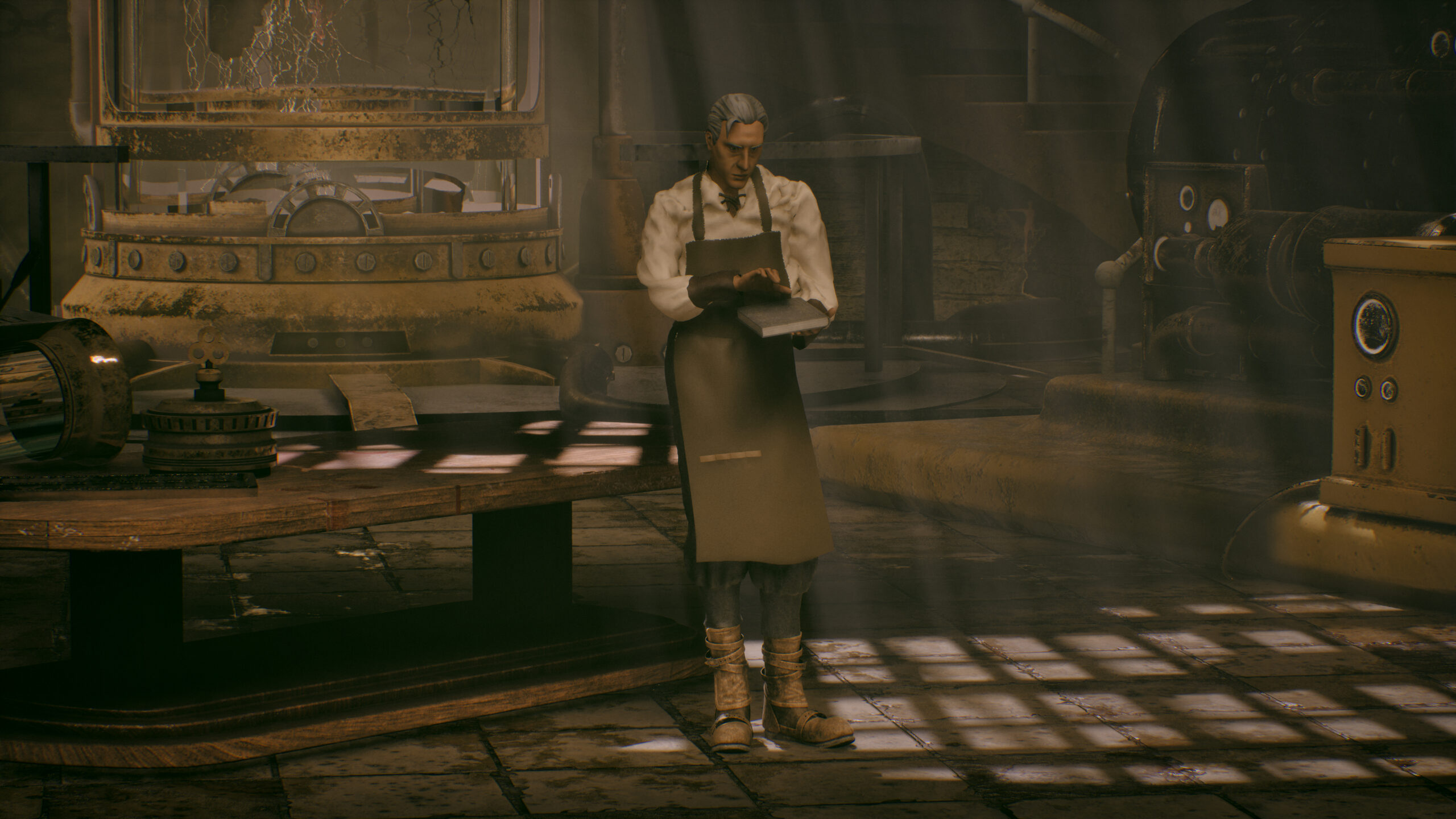
Reflect and set off for the next journey
This week, our team took a moment to look back on our achievements, putting together a comprehensive post-mortem and organizing all our production materials, final renders, and the NDisplay user manual. These efforts are essential for ensuring that future animation projects can benefit from our experiences and resources. Read on to learn more about our reflections and preparations for what lies ahead.
Project Overview
Introduction
Vial Production is crafting a 3D animation that draws inspiration from Mary Shelley’s Frankeistein. As a classical piece that has been adapted in film and stage performance, the team has taken an innovative approach to produce for different media and tell this story from a different perspective. The animation was specifically tailored for a room-scale 270-degree panoramic screen and 3D stereo glasses, which brings the audience a more immersive watching experience. The equipment-driven design and the use of the nDisplay template allows the team to adapt this work to any similar large screens.The team’s focus extends beyond captivating narratives, audio, and visuals; we also embrace a user-centered approach. This involves considerations for audience positioning and movement, lighting setups, and spatial audio to enhance the immersive environment of our storytelling. For the next step, this animation will be rendered out in a resolution that suits the desktop and mobile devices to enlarge its impact.
Team Members
Ryan Yuan (Producer, Environment Artist), Stefani Wang (Producer, Character Artist), Mia Zhang (Art Director, VFX Artist, Narrative Designer), Zezhong Wu (Environment Artist), Airan Xu (Environment Artist), Ayaka Morito (Graphic Designer, Sound Designer), Jiaxin Li (Character Artist, Sound Designer)
Instructors
John Dessler, Ruth Comley
Consultants
Chris Klug, Ralph Vituccio, Ricardo Washington
What Went Well
Overall
Throughout the semester, our team remained highly motivated, establishing an efficiency-focused pipeline from the outset. Regular internal meetings were held to deliberate on our art direction, ensuring that every team member’s input was valued and incorporated. This seamless collaboration enabled us to maintain a positive working atmosphere and achieve our goals with ease.
Environment
From the beginning of our project, the team established a cohesive color palette and scene reference style, ensuring that assets within our environment adhere to a consistent steampunk aesthetic, resonant with the context of Frankenstein.We collaborated closely with the 3D and 2D art teams to quickly produce a basic block out of the entire environment. With the assistance of the technical artist, we were able to establish the material channel early on. This facilitated the seamless import of materials from Substance Painter into our real-time rendering environment, ensuring consistent visual effects across different rendering settings.
We followed a non-destructive workflow for the project so that we could return to our production files and change details at any time if the project needed. We built a master material considering all application conditions so that we have a universal solution for all the materials used in the project. We also have a solid texture format for the Unreal project so that every time the artist needs to create a new material, he/she just needs to drag the texture maps to the corresponding material slots. The texture details not only enhance visual immersion but also serve as a narrative device, effectively conveying the passage of time.
Moreover, the team has also implemented subtle storytelling into environment assets composition. The content displayed on the board, for example, changes as the time passes by to showcase the timelapse.
Character
The team made strategic choices regarding character development and animation, opting for tools like Mixamo to streamline rigging and animation processes and allocate more time to character development. To enhance pipeline efficiency, models were crafted at various levels of detail.
During the monster’s design phase, the team adhered to the original novel, eschewing movie stereotypes. Initially, the monster was conceived as distinctly inhuman. However, a deep dive into the novel revealed that the doctor crafted the creature with pride, using aesthetically pleasing body parts. The monster remained largely unmentioned until the tale’s conclusion, evoking a sense of disguise and pity. Thus, the team crafted a design that juxtaposed a handsome visage and muscular physique with an overall unnatural and discordant appearance, effectively conveying these nuanced emotions.
Visual Effects
VFX plays a pivotal role in enhancing both the storytelling and visual impact of our animation. Two key VFX sequences stand out: the opening scene, featuring a floating brain within a tank, which serves as a narrative catalyst, setting the tone for the entire clip. Then, the climax, where the electrifying moment of the electrocution occurs, intensifies the story’s emotional depth.
The visual effects and simulation animations were meticulously crafted, effectively immersing viewers in the narrative. They not only looked visually stunning but also seamlessly integrated with the storyline, aiding in comprehension and emotional engagement.
Furthermore, a variety of cutting-edge technologies were employed in the creation of these VFX. Houdini’s particle systems were utilized for the underwater simulation, while Blender’s procedural modeling and Geo Nodes brought the intricacies of the moving nerves to life. Lastly, the dramatic electricity effect at the climax was achieved through the utilization of Unreal Engine Blueprint and the powerful Niagara system.
Sound Design
We successfully made a spatial sound in the Cavern. In our animation, there is a scene in which the character walks away from the left side and returns from the right side of the screen. Many playtesters cannot find this because we cannot make any visual hints to lead their attention from the back left side to the back right side. The spatial sound effects made up for this shortfall and let the audience understand the characters are walking outside the screen, just behind them.
Graphic Design
Graphic design could be the most inconspicuous but important part of the project because we start from the title and end with the credit list. They could briefly show our direction and style: filmlike horror animation.
For the title scene, we tested several fonts, including serif and sans-serif typefaces. Since we wanted to make our animation in a filmlike style, we finally decided to use Baskerville Old Face. We also slowed the title’s fade-out lengths to create a tense atmosphere.
For the credit list, we didn’t just scroll the members’ names from the screen’s bottom to the upside but used a few scrolling motions in plenty of parallel space to guide the audience’s gaze to make them not get bored.
What We Could Do Better
Communication
While internal collaboration and communication within the team remained smooth and efficient, external communication with instructors proved somewhat inconsistent. Implementing a robust platform for submitting project updates and facilitating feedback exchange would significantly streamline communication and problem-solving processes for both parties involved.
Character
From an artistic standpoint, due to our constrained schedule, both the modeling and texturing processes were completed with efficiency taking precedence over visual perfection. While we aimed to imbue the monster with a handsome appearance, there is a concern that we may have inadvertently downplayed its monstrous nature. Additionally, the animation loop could be better executed with more time provided.
Visual Effects
While our visual effects were well-executed overall, there are areas where refinement can elevate their realism and impact. For instance, in the opening scene, the formation of the bubbles could be enhanced to closely mimic the natural dynamics of underwater bubbles, thus heightening the immersion for the audience. Additionally, in the electrifying climax, the shape and detailing of the electricity beam can be improved for a more dramatic and visually striking effect. By focusing on these aspects, we can ensure that every visual element enhances the narrative and captivates the viewer.
Graphic Design
We could shorten our credit list because it is still too long for a 3-minute animation. Showing our team members’ names takes about one-third of the animation’s time, sometimes boring the audience.
Sound
The audio equipment should be checked during the sound design process. The sound sounded clear when we edited it in the DAW software, but we didn’t expect the speaker’s condition to change on the last day.
Lessons Learned
Environment
We have gained valuable insight into the proper workflow for an animation production and the process of constructing a real-time environment within UE5. This project has provided us with hands-on experience in various essential tasks such as modeling, UV unwrapping, texturing, and asset placement in UE5, equipping us with essential skills for our future projects. We also discovered the potential quality of projects that can be achieved with the right team.
Character
Previously, our focus was solely on character modeling for 3D printing. However, this semester, we expanded our skills to include character modeling and topology tailored specifically for animation purposes. Additionally, we delved into the intricacies of creating realistic skin textures, enhancing my overall understanding of character design and animation. A pivotal aspect of our project was integrating other aspects (environment art, sound, and VFX) into our character development process. This approach proved instrumental in ensuring a cohesive and unified visual aesthetic across all elements of our production.
VFX
Through rigorous exploration of various software and techniques, I’ve developed a comprehensive understanding of creating diverse visual effects and simulations across different genres. I’ve delved into the nuances between particle-based effects and fluid simulations, experimenting with different approaches to achieve desired results and deepening my expertise in the process.
Moreover, at a creative level, I’ve honed my ability to design visual effects that are not just visually appealing but also integral to the narrative and storytelling. I recognize the importance of seamlessly integrating VFX with other elements to convey a cohesive and compelling story. This holistic approach to VFX design ensures that every visual element contributes meaningfully to the overall narrative impact.
Graphic Design
As a graphic designer in this project, I focused on creating a visually compelling story rhythm of opening and credit list animations. Through mastering software tools and emphasizing detail-oriented design, I learned how to make my work’s style match with the whole project. Despite challenges, like learning new software, I embraced growth opportunities and completed my work as requested.
Sound Design
Incorporating sound design into the project, I focused on creating spatial sound, aiming to create immersive audio experiences. It allowed me to manipulate sound sources in three-dimensional space, enhancing the overall narrative and engagement for the audience.
Summary
The team takes immense pride in this project, as each member pushed the boundaries and surmounted challenges. Moving forward, we plan to render the animation in various formats suitable for different screens and submit it for awards consideration. We extend our heartfelt gratitude to our instructors and consultants for their invaluable feedback and unwavering support throughout this journey.
